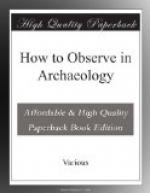2. Identification of ancient sites. This is a task less easy than it appears to be, and many of the current identifications of Biblical sites call for revision. Similarity of name, on which most of these identifications depend, is apt to be misleading; in many cases sites identified thus with Old Testament places are not older than the Byzantine Period. [1] This similarity of name may sometimes be a mere accident; it may also sometimes be accounted for by a transference of site, the inhabitants having for some special reason moved their town to a new situation. In such cases the tell representing the older site may perhaps await identification in the neighbourhood. In attempting to establish identifications, the date of the site, as determined from the potsherds, and its suitability to the recorded history of the ancient site in question, are elements of equal importance with its name.
[1] An example is Khirbet Teku’a, long identified with the Biblical Tekoa.
Note: The traveller should be cautioned against embarking on the study of place-names, identification of scriptural sites, &c., before mastering the principles of Arabic phonetics. Many of the attempts made at rendering the names of Palestinian place-names in European books are simply grotesque. The following are the chief pitfalls:
(1) Confusion of the vowels, the pronunciation
of which is obscure.
(2) The consonant ’ain, to which
the untrained European ear is deaf, and which in consequence
is often omitted. Less frequently it may be over-conscientiously
inserted in a place where it does not exist.
Sometimes the ’ain and its associated
vowel are transposed (as M’alula for
Ma’lula) making unpronounceable combinations
of consonants.
(3) The letter kaf, often dropped in
pronunciation, and therefore
often omitted.
(4) The letter ghain, which an unaccustomed
ear confuses with
either g or r.
(5) The reduplicated letters, which a European
is apt to hear and to
write as single.
(6) The nuances between the different d,
h, k, t, and s
sounds.
3. Surface-exploration of a tell. The stratification can rarely be studied on the surface only: superficial indications of this are obscured by the plough, weather, vegetation, and the activities of modern natives who grub for building-stone and for the chance of buried treasure. Only by trenching can the strata be exposed. An exception to this rule is afforded by Tell el-Hesy (Lachish) explored by Dr. Petrie in 1890- 1: here the erosion of a stream had exposed enough of the strata for a reconnaissance. In the majority of cases the most that a visitor can hope to do is to pick up stray antiquities on the surface of the ground, and ascertain therefrom the limits of date.
The chief clue is afforded by the pottery (see below, V), sherds of which, large and small, are strewn in considerable numbers on every ancient site. Scarabs, seals, bronze implements, iron fragments, beads, bone ornaments, and the like may also be noticed. A trained eye is essential even for such surface finds: one man may walk over a mound and find nothing, another may walk in his steps and gather quite an interesting harvest of small objects.




